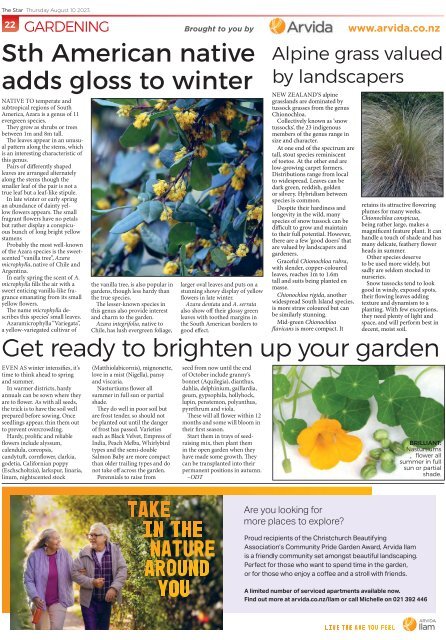The Star: August 10, 2023
Create successful ePaper yourself
Turn your PDF publications into a flip-book with our unique Google optimized e-Paper software.
<strong>The</strong> <strong>Star</strong> Thursday <strong>August</strong> <strong>10</strong> <strong>2023</strong><br />
22<br />
GARDENING<br />
Sth American native<br />
adds gloss to winter<br />
NATIVE TO temperate and<br />
subtropical regions of South<br />
America, Azara is a genus of 11<br />
evergreen species.<br />
<strong>The</strong>y grow as shrubs or trees<br />
between 1m and 8m tall.<br />
<strong>The</strong> leaves appear in an unusual<br />
pattern along the stems, which<br />
is an interesting characteristic of<br />
this genus.<br />
Pairs of differently shaped<br />
leaves are arranged alternately<br />
along the stems though the<br />
smaller leaf of the pair is not a<br />
true leaf but a leaf-like stipule.<br />
In late winter or early spring<br />
an abundance of dainty yellow<br />
flowers appears. <strong>The</strong> small<br />
fragrant flowers have no petals<br />
but rather display a conspicuous<br />
bunch of long bright yellow<br />
stamens<br />
Probably the most well-known<br />
of the Azara species is the sweetscented<br />
“vanilla tree”, Azara<br />
microphylla, native of Chile and<br />
Argentina.<br />
In early spring the scent of A.<br />
microphylla fills the air with a<br />
sweet enticing vanilla-like fragrance<br />
emanating from its small<br />
yellow flowers.<br />
<strong>The</strong> name microphylla describes<br />
this species’ small leaves.<br />
Azaramicrophylla “Variegata”,<br />
a yellow-variegated cultivar of<br />
the vanilla tree, is also popular in<br />
gardens, though less hardy than<br />
the true species.<br />
<strong>The</strong> lesser-known species in<br />
this genus also provide interest<br />
and charm to the garden.<br />
Azara integrifolia, native to<br />
Chile, has lush evergreen foliage,<br />
Brought to you by<br />
larger oval leaves and puts on a<br />
stunning showy display of yellow<br />
flowers in late winter.<br />
Azara dentata and A. serrata<br />
also show off their glossy green<br />
leaves with toothed margins in<br />
the South American borders to<br />
good effect.<br />
Alpine grass valued<br />
by landscapers<br />
NEW ZEALAND’S alpine<br />
grasslands are dominated by<br />
tussock grasses from the genus<br />
Chionochloa.<br />
Collectively known as ‘snow<br />
tussocks’, the 23 indigenous<br />
members of the genus range in<br />
size and character.<br />
At one end of the spectrum are<br />
tall, stout species reminiscent<br />
of toetoe. At the other end are<br />
low-growing carpet formers.<br />
Distributions range from local<br />
to widespread. Leaves can be<br />
dark green, reddish, golden<br />
or silvery. Hybridism between<br />
species is common.<br />
Despite their hardiness and<br />
longevity in the wild, many<br />
species of snow tussock can be<br />
difficult to grow and maintain<br />
to their full potential. However,<br />
there are a few ‘good doers’ that<br />
are valued by landscapers and<br />
gardeners.<br />
Graceful Chionochloa rubra,<br />
with slender, copper-coloured<br />
leaves, reaches 1m to 1.6m<br />
tall and suits being planted en<br />
masse.<br />
Chionochloa rigida, another<br />
widespread South Island species,<br />
is more straw coloured but can<br />
be similarly stunning.<br />
Mid-green Chionochloa<br />
flavicans is more compact. It<br />
www.arvida.co.nz<br />
retains its attractive flowering<br />
plumes for many weeks.<br />
Chionochloa conspicua,<br />
being rather large, makes a<br />
magnificent feature plant. It can<br />
handle a touch of shade and has<br />
many delicate, feathery flower<br />
heads in summer.<br />
Other species deserve<br />
to be used more widely, but<br />
sadly are seldom stocked in<br />
nurseries.<br />
Snow tussocks tend to look<br />
good in windy, exposed spots,<br />
their flowing leaves adding<br />
texture and dynamism to a<br />
planting. With few exceptions,<br />
they need plenty of light and<br />
space, and will perform best in<br />
decent, moist soil.<br />
Get ready to brighten up your garden<br />
EVEN AS winter intensifies, it’s<br />
time to think ahead to spring<br />
and summer.<br />
In warmer districts, hardy<br />
annuals can be sown where they<br />
are to flower. As with all seeds,<br />
the trick is to have the soil well<br />
prepared before sowing. Once<br />
seedlings appear, thin them out<br />
to prevent overcrowding.<br />
Hardy, prolific and reliable<br />
flowers include alyssum,<br />
calendula, coreopsis,<br />
candytuft, cornflower, clarkia,<br />
godetia, Californian poppy<br />
(Eschscholtzia), larkspur, linaria,<br />
linum, nightscented stock<br />
(Matthiolabicornis), mignonette,<br />
love in a mist (Nigella), pansy<br />
and viscaria.<br />
Nasturtiums flower all<br />
summer in full sun or partial<br />
shade.<br />
<strong>The</strong>y do well in poor soil but<br />
are frost tender, so should not<br />
be planted out until the danger<br />
of frost has passed. Varieties<br />
such as Black Velvet, Empress of<br />
India, Peach Melba, Whirlybird<br />
types and the semi-double<br />
Salmon Baby are more compact<br />
than older trailing types and do<br />
not take off across the garden.<br />
Perennials to raise from<br />
seed from now until the end<br />
of October include granny’s<br />
bonnet (Aquilegia), dianthus,<br />
dahlia, delphinium, gaillardia,<br />
geum, gypsophila, hollyhock,<br />
lupin, penstemon, polyanthus,<br />
pyrethrum and viola.<br />
<strong>The</strong>se will all flower within 12<br />
months and some will bloom in<br />
their first season.<br />
<strong>Star</strong>t them in trays of seedraising<br />
mix, then plant them<br />
in the open garden when they<br />
have made some growth. <strong>The</strong>y<br />
can be transplanted into their<br />
permanent positions in autumn.<br />
–ODT<br />
BRILLIANT:<br />
Nasturtiums<br />
flower all<br />
summer in full<br />
sun or partial<br />
shade.


















